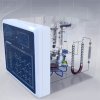Programming languages, such as Java and C, may no longer necessitate a computer as the platform to carry out a set of instructions. Researchers at University of Washington believe they have developed a chemical programming language for use in networks that can guide the behavior of chemical reactions. The engineering and design process that goes into creating a molecular network is extremely complex, which is why UW engineers set out to create a framework to be used in such endeavors. The framework would consist of synthetically designed DNA molecules, which code for specific molecules with very narrowly defined functions. DNA, like in most programming languages, uses a unique code-sequence to represent a specific outcome. To that end, a synthetic DNA could be designed which codes for molecules engineered in the lab, that have specific bodily functions.
dna language machine Chemical Programming Language May Enable the Development of Synthetic DNAApplications of synthetically designed molecular networks in the world of medicine are practically endless. Most biological systems like humans and other organisms already have complex networks of nanomolecules that help regulate cell and body functions. Synthetic nanomolecular networks with the ability to support the body’s natural functions could open up many avenues of medical applications, such as improvements to daily life, new treatment methods, reducing rehabilitation periods, altering metabolic functions, and even improving upon existing human capabilities. An even more advanced application for such a technology, that may be a possibility in the not-too-distant future, is the creation of self-assembling “smart sensors” embedded within cells or in the bloodstream.
While this research is not ready to be applied to the medical field yet, it represents new potentials that have not been within humankind’s reach in the past. Hopefully, upon completion of this research, the medical industry will start to see new embedded nanomolecular devices for use in and around the body, that could greatly simplify the practice of medicine as we know it today.
Abstract from Nature Nanotechnology:
“Biological organisms use complex molecular networks to navigate their environment and regulate their internal state. The development of synthetic systems with similar capabilities could lead to applications such as smart therapeutics or fabrication methods based on self-organization. To achieve this, molecular control circuits need to be engineered to perform integrated sensing, computation and actuation. Here we report a DNA-based technology for implementing the computational core of such controllers. We use the formalism of chemical reaction networks as a ‘programming language’ and our DNA architecture can, in principle, implement any behavior that can be mathematically expressed as such. Unlike logic circuits, our formulation naturally allows complex signal processing of intrinsically analogue biological and chemical inputs. Controller components can be derived from biologically synthesized (plasmid) DNA, which reduces errors associated with chemically synthesized DNA. We implement several building-block reaction types and then combine them into a network that realizes, at the molecular level, an algorithm used in distributed control systems for achieving consensus between multiple agents.”
source:Nature Nanotechnology
Chemical Programming Language May Enable the Development of Synthetic DNA

